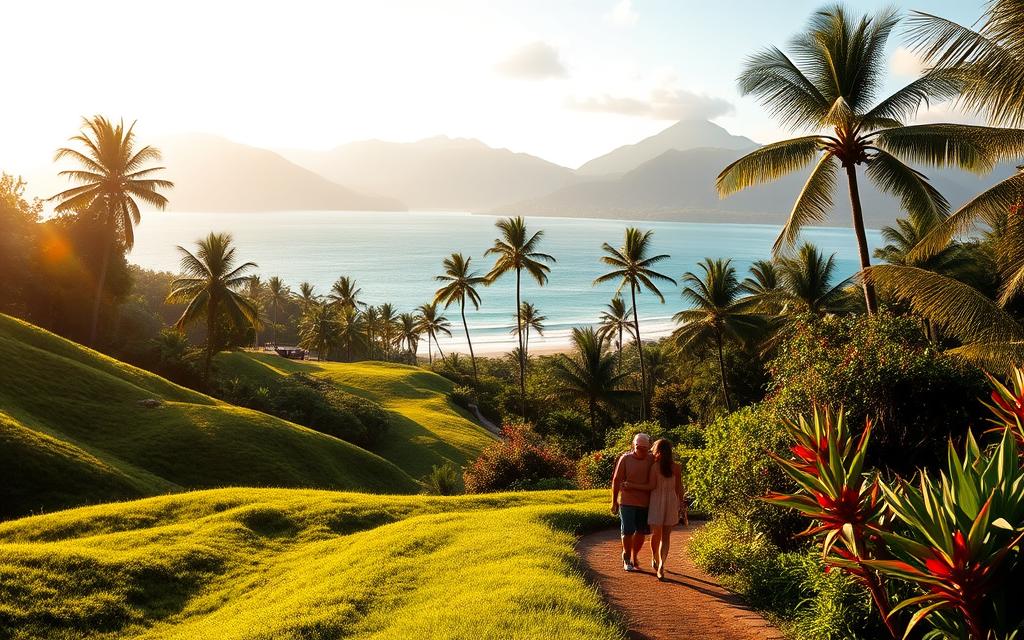Costa Rica Permanent Residency Requirements: Your Guide

Did you know that over 70,000 expats have chosen to call Costa Rica home? This tropical paradise is not just a vacation destination but a place where families and individuals can enjoy an improved quality of life. With its stunning natural beauty, mild climate, and rich culture, it’s no wonder so many are drawn to this welcoming country.
For those considering a long-term stay, obtaining a residence permit is essential. Whether you’re looking to retire, invest, or simply enjoy the laid-back lifestyle, understanding the application process is key. This guide will walk you through the steps to achieve permanent resident status and unlock the benefits of living in this vibrant nation.
From navigating the requirements to preparing your documents, we’ll provide expert tips to make your journey smooth and successful. Let’s explore how you can make Costa Rica your new home.
Introduction to Costa Rica Residency

Costa Rica has become a top choice for expats seeking a better quality of life. Its warm climate, stunning landscapes, and welcoming culture make it an ideal destination for those looking to start anew. Whether you’re drawn to its pristine beaches or lush rainforests, this country offers a unique blend of natural beauty and modern convenience.
Why Costa Rica is an Attractive Destination
One of the main reasons people choose Costa Rica is its “pura vida” lifestyle. This phrase, meaning “pure life,” reflects the country’s focus on simplicity, happiness, and community. Expats often find themselves embracing a slower pace of life, surrounded by friendly locals and a vibrant expat community.
Another key factor is the country’s high-quality healthcare system. Residents have access to affordable medical services, ensuring peace of mind for families. Additionally, the legal entry procedures are straightforward, making it easier for newcomers to settle in.
Exploring the Benefits of a New Lifestyle
Choosing to live in Costa Rica can lead to significant positive changes. The relaxed atmosphere encourages a healthier work-life balance, while the natural surroundings provide endless opportunities for outdoor activities. Families often find that the country’s emphasis on community and education creates a nurturing environment for children.
For those planning long-term, Costa Rica offers a stable and welcoming environment. Its commitment to sustainability and environmental protection ensures that future generations can continue to enjoy its beauty. With so many advantages, it’s no wonder this country is a top choice for expats worldwide.
Overview of Residency Options in Costa Rica

Costa Rica offers a variety of residency options to suit different lifestyles and financial situations. Whether you’re planning to retire, invest, or simply enjoy a new way of life, understanding the available types is essential. The country provides both temporary and permanent solutions, each with its own benefits and requirements.
Temporary vs. Permanent Residency
Temporary residency is often the first step for newcomers. It allows individuals to live in the country for a set period, typically three years. During this time, applicants can explore the lifestyle and decide if they want to pursue permanent status. Temporary options include categories like Rentista, Investor, and Pensionado, each tailored to specific financial profiles.
Permanent residency, on the other hand, is ideal for those looking to settle long-term. After maintaining temporary status for at least three years, individuals can apply for permanent residency. This type offers greater stability and fewer renewal requirements, making it a popular choice for expats.
Popular Categories: Rentista, Investor, and Pensionado
The Rentista category is designed for individuals with a stable, unearned income. Applicants must show at least $2,500 per month, totaling $60,000 over two years. This option is perfect for those who don’t work but have reliable financial resources.
For those looking to invest, the Investor category requires a minimum of $200,000 in tangible property or projects of national interest. This type is ideal for individuals who want to contribute to the local economy while securing their residency.
The Pensionado category caters to retirees with a guaranteed pension of at least $1,000 per month. This option is popular among those seeking a relaxed lifestyle in a beautiful setting. For more details on legal requirements, visit our guide on residency requirements.
Each type of residency offers unique benefits, making it important to choose the one that aligns with your goals. Whether you’re an investor, retiree, or someone with a steady income, Costa Rica has a solution tailored to your needs.
Costa Rica permanent residency requirements: Key Considerations

Proper documentation is the foundation of a successful application process. To ensure eligibility, applicants must meet specific legal criteria and provide accurate records. Understanding these requirements can help avoid delays and complications.
Eligibility Criteria and Legal Requirements
To qualify, applicants must demonstrate compliance with government standards. This includes submitting a valid birth certificate, marriage certificate (if applicable), and a police clearance record. These documents must be authenticated to meet local legal norms.
For those who have spent significant time abroad, a police record from their home country is often required. If the applicant is not from an Apostille Convention country, the document must be legalized at the appropriate embassy. This ensures the authenticity of the records.
Meeting Government Standards
Adhering to government regulations is critical for a smooth application process. All documents must be translated into Spanish and notarized to meet local requirements. This step ensures that the paperwork is legally recognized and processed efficiently.
Compliance with these standards not only simplifies the process but also demonstrates the applicant’s commitment to following the law. For more details on legal requirements, visit our guide on residency requirements.
By preparing thoroughly and meeting all criteria, applicants can navigate the process with confidence. Proper documentation and adherence to legal norms are the keys to unlocking a successful long-term stay.
Navigating the Application Process

Applying for a long-term stay in a new country can seem overwhelming, but with the right guidance, it’s manageable. The process involves several steps, from gathering documents to working with immigration authorities. Understanding each stage can help ensure a smooth experience.
Steps to Apply from Abroad
Starting the process from abroad requires careful planning. First, applicants must obtain a provisional visa, which allows them to enter the country legally. This step is crucial for those who plan to stay beyond the typical tourist period.
Next, fingerprint registration is mandatory. This process helps verify identity and ensures compliance with local laws. It’s important to schedule this step early, as delays can impact the overall timeline.
Finally, submitting the application through the correct channels is essential. Working with experienced professionals can help avoid common pitfalls and ensure all requirements are met.
How to Transition from a Tourist Visa
Transitioning from a tourist visa to a long-term permit involves specific steps. First, applicants must ensure they meet the eligibility criteria, including proof of income or investment. This step is critical for a successful application.
Timing is also key. Applications should be submitted well before the tourist visa expires to avoid legal complications. Planning ahead can save time and reduce stress.
Working closely with immigration authorities is another important factor. They can provide guidance on required documents and help navigate any challenges that arise during the process.
By following these steps and staying organized, applicants can successfully transition from a tourist visa to a long-term permit. Proper preparation and attention to detail are the keys to a smooth application process.
Preparing Your Documentation for Success

Properly preparing your documents is the key to a smooth application process. Ensuring all paperwork is complete, accurate, and properly translated can save time and prevent delays. Let’s break down the essential steps to get your documentation in order.
Essential Documents and Their Translations
Start by gathering the necessary paperwork. Key documents include your birth certificate, marriage certificate (if applicable), and a letter of application. These records must be in good condition and up-to-date.
Once you have the originals, the next step is translation. All documents must be translated into Spanish by a certified translator. This ensures they meet local legal standards and can be processed efficiently.
Legalization and Notarization Procedures
After translation, legalization is crucial. For countries part of the Apostille Convention, an apostille stamp is required. This certifies the authenticity of your documents. If your country is not part of the convention, legalization must be done at the appropriate embassy.
Notarization is the final step. A notary public must verify the authenticity of your documents. This includes certified copies of your originals. Proper notarization ensures your paperwork is legally recognized.
By following these steps, you can ensure your documentation meets all requirements. For more details on the residency process, visit our comprehensive guide.
Understanding Financial and Investment Criteria
Financial stability is a cornerstone of the application process for long-term stays. To qualify, applicants must meet specific income and investment thresholds. These criteria ensure that individuals can support themselves and contribute to the local economy.
Proving Sufficient Income and Investments
Applicants must demonstrate a stable monthly income or a significant investment. For example, retirees need a guaranteed pension of at least $1,000 per month. Those with unearned income must show $2,500 per month, totaling $60,000 over two years.
Investors are required to commit a minimum of $150,000 in tangible assets. This could include real estate, stocks, or business ventures. Bank statements and financial records are essential to prove these funds.
Maintaining consistent monthly income records is crucial. Immigration authorities review these documents to assess financial stability. Providing clear and accurate records enhances credibility and speeds up the process.
Acceptable financial documents include pay stubs, employment contracts, and bank statements. These must be translated into Spanish and notarized to meet local requirements. Properly structuring your financial proofs strengthens your application.
For more details on transitioning from temporary to long-term status, visit our guide on residency transitions.
Family, Work, and Dependents Considerations
Moving to a new country with your family involves careful planning and understanding the legal processes. Whether you’re bringing a spouse, children, or other dependents, it’s essential to know how to include them in your application. Additionally, understanding the differences between work permits and residency rights can help you make informed decisions for your family’s future.
Including Dependents in Your Application
When applying for long-term status, you can include your spouse and children under 25 as dependents. This allows your family to enjoy the same benefits, such as access to healthcare and education. For dependents over 25, proof of physical or mental dependency may be required.
To include family members, you’ll need to provide specific documents. These include marriage certificates for spouses and birth certificates for children. All paperwork must be translated into Spanish and notarized to meet local requirements.
Demonstrating adequate income to support your dependents is also crucial. Authorities will review your financial records to ensure you can provide for your family. This step is vital for a successful application.
Work Permit vs. Residency Options
Understanding the distinction between a work permit and full residency rights is important. A work permit allows you to legally work in the country but may not include the same benefits as residency. For example, temporary residents with work permits may face limitations on their ability to access certain services.
On the other hand, full residency offers greater stability and freedom. Residents can work without additional permits and enjoy long-term benefits. This option is ideal for families planning to settle permanently.
When deciding between the two, consider your long-term goals. If you plan to work temporarily, a permit may suffice. However, for those seeking a permanent home, full residency is the better choice.
By carefully evaluating your options and preparing the necessary documents, you can ensure a smooth transition for your family. Proper planning and understanding of the process are key to success.
Exploring Alternative Visa Options
Not ready for a long-term commitment? Costa Rica provides alternative visa programs for short-term living. These options are ideal for individuals seeking flexibility while enjoying the country’s vibrant culture and natural beauty. Whether you’re a digital nomad or planning a temporary stay, there’s a visa tailored to your needs.
Digital Nomad and Temporary Residency Visas
The Digital Nomad Visa is perfect for remote workers. It allows you to live and work in Costa Rica for up to two years, with the option to renew. To qualify, you’ll need a monthly income of $3,000 (or $4,000 for families). This visa is ideal for those who want to experience the country without a permanent move.
Temporary residency visas are another great option. These include categories like Rentista and Pensionado. The Rentista visa requires a steady income of $2,500 per month or a bank deposit of $60,000. The Pensionado visa, designed for retirees, requires a guaranteed pension of at least $1,000 per month.
Both visas offer two-year terms and can be renewed. They provide a pathway to permanent residency if you decide to stay longer. However, temporary visas have fewer requirements compared to permanent status, making them accessible for many.
When choosing a visa, consider your long-term goals. If you’re unsure about settling permanently, temporary options offer flexibility. For those planning to retire, the Pensionado visa is a popular choice. Digital nomads will find the dedicated visa program aligns perfectly with their lifestyle.
By understanding these alternatives, you can select the right visa for your needs. Whether you’re seeking a short-term adventure or a stepping stone to long-term living, Costa Rica has a solution for you.
Expert Tips for a Smooth Transition to Costa Rica
Transitioning to a new country can be a rewarding experience with the right preparation. To ensure a seamless process, it’s essential to understand local procedures, avoid common mistakes, and stay organized. Here’s how you can navigate the journey effectively.
Navigating Local Procedures and Laws
Understanding local immigration laws is the first step. Familiarize yourself with the required documents, such as birth certificates, police clearances, and proof of income. These must be translated into Spanish and notarized to meet local standards.
Timing is critical. Start gathering your paperwork early to avoid delays. For example, police clearance records can take weeks to process, so plan accordingly. Working with a local expert can help you navigate bureaucratic procedures efficiently.
Common Pitfalls and How to Avoid Them
One of the most common mistakes is incomplete or inaccurate documentation. Double-check all forms and ensure translations are certified. Missing even one detail can lead to significant delays.
Another pitfall is underestimating the time required for the process. Applications can take several months, so apply well before your current status expires. Staying proactive and organized will save you time and stress.
For more guidance on ensuring a smooth application process, visit our detailed guide.
By following these expert tips, you can streamline your transition and focus on enjoying your new life. Proper preparation and attention to detail are the keys to success.
Conclusion
Making the move to a new country can be both exciting and challenging. This guide has outlined the diverse pathways available for achieving long-term status, from financial criteria to legal requirements. Thorough documentation and expert advice are essential for a smooth transition.
With careful planning, settling into your new home is entirely achievable. Whether you’re a retiree, investor, or seeking a fresh start, the country offers opportunities to build a fulfilling life. Exploring real estate options can further enhance your experience.
For personalized guidance, consider consulting professionals who specialize in the process. Their expertise can help turn your dream of citizenship into reality. Start your journey today and embrace the vibrant lifestyle that awaits you.


